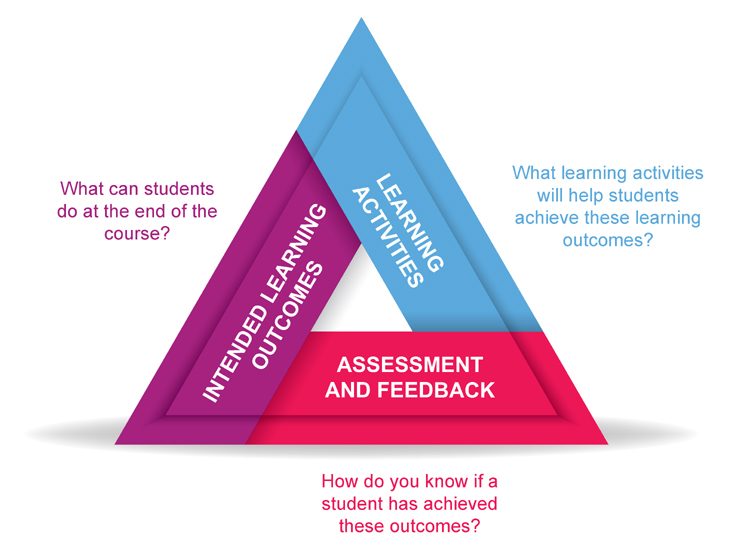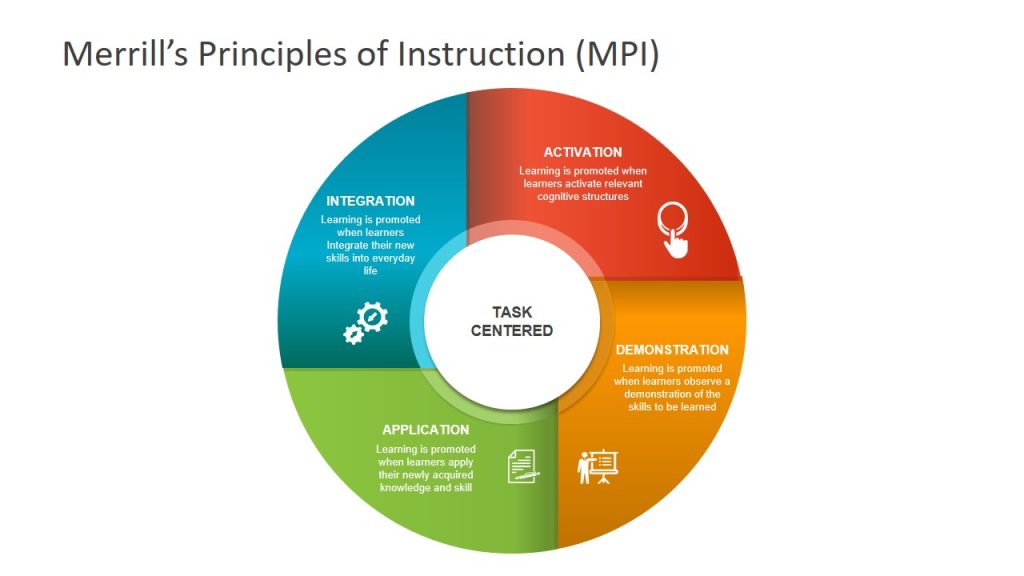Good learning experiences don’t just happen – they are the product of careful planning and meticulous design. Interactive and multimedia learning design should always serve the learning objectives, so it’s important to know how an instructional designer would approach creating interactive and multimedia learning in support of a lesson or course. In this module, we take a look at some of the common instructional design and lesson planning principles and models that help us systematically plan learner-centred and effective learning experiences.
In this module we also look at the benefits of active learning and explore some of the ways that media and multimedia can support these activities. Lecturing (which is quite different from storytelling) has been the predominant mode of instruction since universities were founded in Western Europe over 900 years ago. But educational theorists have been challenging this ‘teaching by telling’ approach for many years and research continues to show that active learning can dramatically improve student learning outcomes. We’ll explore H5P, a powerful tool for creating fun and engaging interactive learning objects to add more active learning to your lessons.
Learning Outcomes
By the end of this module you will be able to:
- Recognize a lack of constructive alignment in learning outcomes, assessment and activities.
- Describe the process of backward design.
- Use a planning template to apply backward design to a lesson that contains a media or multimedia activity.
- Describe Merrill’s Five Principles of Instruction.
- Identify examples of media and multimedia activities that can be used to support Merrill’s principles in a learning environment.
- Describe six strategies for bringing active learning into a learning environment with media or multimedia
- Differentiate between active and passive learning
- Describe the connection between active learning and higher order thinking in Bloom’s Taxonomy
- Apply scaffolding to learning design that incorporates active learning
- Identify four evidence-based learner outcomes from using active learning in the classroom
- Create an interactive learning object with H5P
Read/Watch
- Merrill’s First Principle of Instruction – (20 min) – A synthesis of Merrill’s principles from an instructional design perspective.
- Merrill on Instructional Design – (5 min)- Merrill is one of the pioneers of modern instructional design thinking from a problem-centred perspective. He reflects here in particular on multimedia design and delivery.
- Lessons in Learning (5 min) – A summary of the landmark study from Harvard University about the impacts and challenges of Active Learning.
- Constructive Alignment – (3 min) – An overview of the concept of constructive alignment in instructional design.
- Backward Design – (6 min) – Another amazing video from local educator Shelley Moore explaining the principles of backward design and a ‘flip-book’ approach to curriculum design that promotes inclusion.
- Backward Design: The Basics (15 min) – A teacher reflects on their experience with learning to use Backward Design techniques for lesson design (also available as a podcast)
- To Learn Students Need to DO Something (15 min) – A reflection on the need for active learning in K-12 along with some suggestions for classroom activities
- Bloom’s Taxonomy (5 min)- New to Bloom’s Taxonomy? Here’s a quick introduction.
- Game-based Learning (5 min) – Using game-based learning to tell a story about the history of civilization using active learning.
- What Is Scaffolding in Education? | GCU Blog (10 min) – What do we mean when we talk about scaffolding in education?
- Active Learning Overview (5 min) – An overview of active learning and its importance in learning design.
- An Active Learning Example (4 min) – Active learning activity design in a physics lab.
- Active Learning in STEM (5 min) – Active learning at work in a STEM class.
Resources
- How to enable H5P on your WordPress site – Instructions from the UVic Library to help you enable H5P on your WordPress site
- H5P Tutorials – How to create any of the over 30 content types available in H5P
- How to embed H5P in your WordPress page using shortcode.
- H5P with ChatPT – You can create an interactivity twice as fast with an assist from ChatGPT. (But don’t forget to review, evaluate and edit the results).
Principles of Learning Design
Instructional Design
Instructional Design is a complex set of skills with a long history. A full understanding of it is beyond the scope of this course, so instead we will focus on some key principles and then apply them to media and multimedia learning design.
At the core of instructional design is a series of planning decisions about 5 things:
- Big Ideas
- What ideas are critical for learners at this stage of their learning path?
- Learning Outcomes
- What knowledge, skills or attitudes will learners have at the end of this program/course/lesson?
- Evidence of Learning
- What evidence would demonstrate the knowledge, skill or attitude described in these outcomes?
- Assessment
- How will you capture that evidence? What will learners do to demonstrate their understanding?
- Learning Activities
- What learning activities will allow learners to acquire and practice the skills necessary to demonstrate their learning and complete the assessment successfully?
You’ll notice that Learning Activities is at the end of this list. This supports two important ideas in instructional design – Constructive Alignment and Backward Design, both approaches that help ensure that the ideas and outcomes for the course are driving the design.

Constructive Alignment refers to the alignment of our learning outcomes, assessments, and activities. Constructive Alignment is also central to the concept of Backward Design, in which you start with your intended outcomes, then plan how you will assess those outcomes, and finally design the learning activities that prepare students for those assessments.
So rather than jumping into creating media and multimedia activities and resources for your lesson or course, you have a clear picture of what these activities need to deliver in order to prepare students for the assessments, which demonstrate their accomplishment of the learning outcomes, which are based on the big ideas.
For example, if I had created a lesson on Constructive Alignment, the planning process might have looked like this:
| Big Idea | Learning Outcome | Evidence of Learning | Assessment | Learning Activities |
| Aligned and coherent learning design promotes constructivist learning | By the end of this lesson you will be able to: Recognize misalignment in outcomes, assessment and activities in a lesson design | An accurate example of alignment or misalignment in a lesson design | A blog post demonstrating use of a planning template and reflecting on process | Watch video demonstration of alignment and misalignment and discuss with Learning Pod-Practice using a planning template |
And then I would identify what key information needed to be included in the lesson, think of media that would support that, and start creating an outline for my lesson.
Every learning experience needs learning outcomes to help focus the goals. Think about Mayer’s Coherence principle – how do we know if some piece of information belongs in our course/lesson/media/multimedia and is not extraneous? Because it is aligned with our learning outcomes.
Active Learning
Image credit: Bryan Mathews
Active Learning is a set of teaching strategies that engages students as active participants in their own learning, on their own or in collaboration with others. In the traditional, teacher-centred lecture format, students are passive observers, ‘consumers’ of learning. Active learners are ‘producers’ of learning. In the language of Bloom’s Taxonomy, active learning encourages learners to bring higher order thinking skills to engage with the topic which ultimately leads to better integration of the key concepts and skills.

Active learning is also closely associated with learning design strategies that we have already studied such as student-centred learning (from Universal Design for Learning).
Research shows that this approach has many beneficial outcomes for learners including:
- Improved critical thinking/problem solving skills and increased content knowledge understanding in comparison to traditional lecture-based delivery (Anderson et al, 2005)
- Greater persistence. Students in courses without active learning were 1.5 times more likely to fail than students in a course that included active learning (Freeman et al, 2014).
- Increased enthusiasm for learning in both students and instructors (Thaman et al., 2013)
- Development of essential skills such as critical and creative thinking, adaptability, communication and interpersonal skills (Kember & Leung, 2005)
Active vs. Passive Learning
So active learning improves learning outcomes and creates a better learning experience for both instructors and students. Why would you ever do anything else? While it’s critical to include active learning in our lesson plans, sometimes passive learning can be a useful tool for introducing new terminology or foundational knowledge. We’ve already established that storytelling is a powerful teaching strategy which doesn’t appear to inspire active learning but actually generates a lot of physical and mental responses. Watching a demonstration, reading an essay, listening to a story – these can provide valuable learning experiences that can be reinforced with active learning. Sometimes in our eagerness to add active learning to our teaching, we forget that there needs to be some scaffolding of knowledge and skill in order for students to be able to complete the activity successfully. As a teacher you need to be able to recognize the strengths of both types of learning to use them effectively.
Active Learning and Multimedia
Adding active learning to media and multimedia design can be as simple as adding questions before, during or after viewing media. It can also mean building in much more complex interactivity, such as branching scenarios and interactive case studies. However, complexity does not always equal better outcomes for learners. As always, we want to make sure that our multimedia tools and content serve the learning objectives. Sometimes the simplest approach with the fewest barriers provides the best outcomes.
Some examples of the ways that multimedia can support active learning include:
- Simulating the evolution of systems over time (Biology games and simulations)
- Designing large scale simulated environments (Energy 3D)
- Gathering and analyzing real world data (City of Vancouver Open Data Portal, Tableau, R Studio)
- Providing platforms for expression and reflection (WordPress, ArcGIS Storymaps)
- Social annotation of content (Hypothes.is, VideoAnt)
- Conceptual mapping (Canva, Free Mind)
- Collaborative writing and publishing (Pressbooks, Scalar)
- Discussion and communication (Mattermost, Discord, Slack)

Principles of Instruction
One of the most useful learning theories from an active learning design perspective is Merrill’s First Principles of Instruction. If you’re an Education student you have no doubt come across this before in your studies.

Merrill’s First Principles are focused on a problem-solving approach to learning design. What authentic problem can we solve with this lesson that is meaningful to learners? He theorized that learning is promoted when:
- Learners are engaged in solving real-world problems
- Existing knowledge is activated as a foundation for new knowledge
- New knowledge is demonstrated to the learner
- New knowledge is applied by the learner
- New knowledge is integrated into the learner’s world
So how do we facilitate this process with the use of media and multimedia? By helping to create an environment where this type of learning can take place. As Merrill himself pointed out in the video in Read/Watch this week, just the use of media and multimedia doesn’t promote learning. It’s how you use them that counts. Here are some examples:
Activation and Demonstration:
- Videos can show real-world examples and demonstrate procedures
- Animations can demonstrate complex systems in ways that aren’t visible to the human eye.
- Infographics can help learners activate past knowledge by giving them a quick reference to remind them of key terminology and information
- Augmented reality can be overlaid on an environment to show hidden information in context
Application:
- Interactive activities can supply quick formative feedback on learning concepts
- Branched scenarios can be used to explore a complex case study
- Simulations can provide decision-making practice in a semblance of real-world scenarios
And of course an interactive multimedia learning object like a branched scenario simulation could encompass all of these principles – it could simulate a real-world problem, activate prior learning, demonstrate and then allow the learner to practice and integrate the knowledge, skill or attitude.
Explore: Lesson Planning Template and H5P
In this module, we will be using a lesson template to practice planning a lesson using the principles backward design. The benefit of using this type of planning template is that it gives you a bird’s eye view of your course before you begin building content. This will help prevent you from wasted time and effort on content and activities that are not aligned with the outcomes for the lesson.
You can use it to start planning your final project for the course or practice by looking at a lesson that already exists.
H5P
H5P is a free, versatile, open source authoring tool integrated with WordPress and many other platforms that allows you to quickly create, share and reuse a wide variety of interactive and engaging learning activities. Pre-built interactivities such as drag and drop, hot spots, fill in the blanks or more complex interactions such as branched scenarios and interactive videos create opportunities for students to rehearse their knowledge and decision-making in engaging ways while instructors are able to track their progress. The activities are fully responsive, which makes them accessible to students using mobile devices.

H5P provides a set of tutorials to help you explore and experiment with over 30 different content types. For example, you could make a video that you’ve already created interactive by using the Interactive Video activity. In order to work with H5P in your WordPress site you need to enable it. Follow the instructions from the UVic Library to set it up on your site and try creating one or more interactivities. Add them to your blog post for this module using shortcode.
In addition to creating your own H5P interactive learning content, there are open source repositories of H5P objects licensed under Creative Commons for reuse including:
- Catalogue of H5P Content | eCampusOntario H5P Studio
- The H5P OER HUB | H5P (under construction)
- Discover | Learnful
Reflections
As always, these questions are intended as an inspiration for your blogs, not a prescription. So use one of the questions if it sparks ideas or choose your own reflection on this week’s topic. Be sure to include a copy of your lesson planning document and an example of your work in H5P.
- What is your experience with video game learning supports? Which principles (Mayer’s and Merrill’s) seem to be commonly applied in in-game support and which ones are often missed in your experience?
- What authentic problem would you use to design a lesson using Merrill’s principles? What media or multimedia (interactive or not) would you create to support it?
- Where do you see constructive alignment and backward design used in this course or another course you are taking/have taken? Is there anywhere where it seems to be missing?
- Historia, the example of game-based learning in this week’s Read/Watch list is relatively low tech – how would you use multimedia tools and content to support and enhance the active learning? What would it allow them to do that they’re not doing right now?
- How have you found the balance of passive and active learning in this course for your learning? How does it compare to your experience in other courses?
- What was your experience of trying out H5P? Which of the activities do you think you would make most use of in your teaching context and what would you use them to do? Which ones do you think require the most resources to create?
- In the reading, Students Need to DO Something, do any of the author’s experiences with passive learning in K-12 classrooms resonate with your own? Why do you think active learning is not more prevalent in K-12? Have you tried using any of these activities in a classroom? Which one looks most appealing to you?
- Can you describe (step by step) an example of scaffolding in a learning experience that you’ve designed or experienced?
To Do
- Read/watch the weekly Announcements forum posts in Brightspace (or in your email inbox if your notifications are set up that way).
- Follow the instructions from the UVic Library to set up H5P on your WordPress site. (Note that if you used the template for the course for your WordPress setup, the H5P setup might get hung up – if this happens let me know (along with your site URL) and I can follow up with OpenETC.)
- Create an interactive learning object with H5P and add it to your post.
- Using the lesson planning template (see below), create an overview plan for a lesson and add it to your post. It could be related to the one your group will be creating for the final project or it could be something you’re interested in on your own.
- Choose some of the reflection questions to help you write your blog post reflection
- Comment on at least one other classmate’s posts.
References
Looking for a deeper dive? Explore some of these references:
Biggs, John, Constructive Alignment in University Teaching, HERDSA Review of Higher Education Vol. 1, www.herdsa.org.au
Kurt, S. “Instructional Design Models and Theories,” in Educational Technology, December 9, 2015. Retrieved from https://educationaltechnology.net/instructional-design-models-and-theories/ Dr. Serhat Kurt, Instructional Design Models and Theories. Sept 28, 2022.
Merrill, M. D. (2002). First Principles of Instruction. ETR&D, 50, 3. pp. 43-59.
Wiggins, G. and McTighe, J. Understanding by Design. 2nd ed. 2005. Web.
Anderson W., Mitchell S., & Osgood M. (2006), Comparison of student performance in cooperative learning and traditional lecture-based biochemistry classes, Biochemistry and Molecular Biology Education Vol 33, Issue , Pages 387-393 http://onlinelibrary.wiley.com/doi/10.1002/bmb.2005.49403306387/full
Boulenger, Véronique, Olaf Hauk, Friedemann Pulvermüller, Grasping Ideas with the Motor System: Semantic Somatotopy in Idiom Comprehension, Cerebral Cortex, Volume 19, Issue 8, August 2009, Pages 1905–1914, https://doi.org/10.1093/cercor/bhn217
Burrows, S., Collier, A. et al. The Asynchronous Cookbook, Office of Digital Learning & Inquiry, Middlebury College
Centre for Teaching Excellence, Active Learning Activities | Centre for Teaching Excellence | University of Waterloo (uwaterloo.ca) CC-BY-NC
Chow, H. M., Mar, R. A., Xu, Y., Liu, S., Wagage, S., & Braun, A. R. (2014). Embodied comprehension of stories: interactions between language regions and modality-specific neural systems. Journal of cognitive neuroscience, 26(2), 279-295.
Ferster, Bill (2016-11-15). Sage on the screen : education, media, and how we learn. ISBN 9781421421261. OCLC 965172146.
Freeman, Scott, Eddy, Sarah, McDonough, M., Wenderoth, MP (2014) Active learning increases student performance in science, engineering, and mathematics, Psychological and Cognitive Sciences,
https://doi.org/10.1073/pnas.1319030111
Glonek, Katie L. & Paul E. King (2014) Listening to Narratives: An Experimental Examination of Storytelling in the Classroom, International Journal of Listening, 28:1, 32-46, DOI: 10.1080/10904018.2014.861302
González, Julio, Alfonso Barros-Loscertales, Friedemann Pulvermüller, Vanessa Meseguer, Ana Sanjuán, Vicente Belloch, César Ávila, Reading cinnamon activates olfactory brain regions, NeuroImage, Volume 32, Issue 2, 2006, Pages 906-912, ISSN 1053-8119, https://doi.org/10.1016/j.neuroimage.2006.03.037.
Mathers, B. (2017). Wikipedia – Active vs Passive learning. https://bryanmmathers.com/wikipedia-active-vs-passive-learning/ CC-BY-ND (images for Active/Passive Learning interactivity)
Thaman, R.G., Dhillon, S.K., Saggar, S., Gupta, M.P., & Kaur, H. (2013). Promoting active learning in respiratory physiology – positive student perception and improved outcomes. National Journal of Physiology, Pharmacy and Pharmacology, 3, 27-34.







